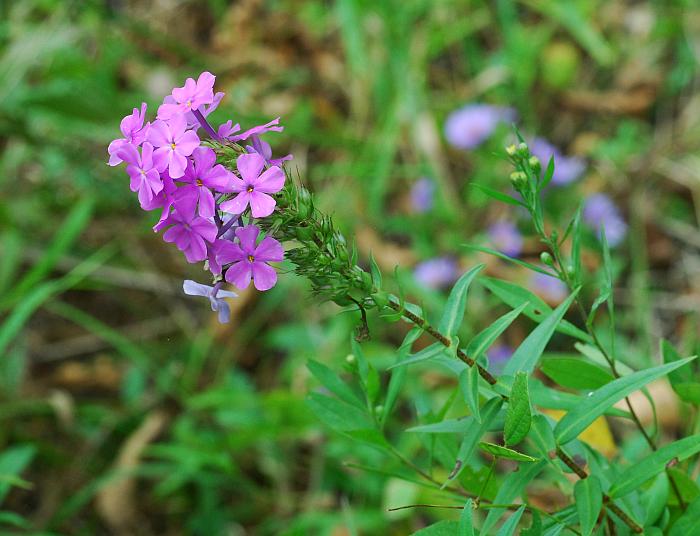Phlox maculata L.
Wild Sweet William

Native
CC = 10
CW = -3
MOC = 10
SRank = S2
© SRTurner
Phlox maculata L.Wild Sweet William | |
 |
Native CC = 10 CW = -3 MOC = 10 SRank = S2 |
© SRTurner |
|
Family - Polemoniaceae Habit - Perennial forb with slender rhizomes. Stems - Erect, usually solitary, to 1 m, glabrous or hairy toward tip, whitish with prominent reddish spots or mottling. Leaf nodes 18-35.
Leaves - Opposite, simple, entire, to 12 cm long, sessile or short petiolate, lanceolate to narrowly lanceolate, sharply pointed, with rounded to cordate bases, glabrous on both surfaces, upper surface glossy, secondary veins obscure and lacking connecting loops.
Inflorescences - Terminal panicles, with sessile to short-stalked clusters of 40-150 flowers, cylindric in outline. Flower stalks to 6 mm.
Flowers - Calyces 5-lobed, 5.5-9.5 mm long, the lobes narrowly triangular, sharply pointed, the midnerve sometimes extended as a short, sharply pointed tip, glabrous. Corollas trumpet-shaped, light pink to pinkish purple, the tube 16-22 mm long, glabrous, the lobes 5-9 mm long and 5-9 mm wide, obovate, rounded at the tips. Stamens with the filaments 9-19 mm long, the anthers positioned near the mouth of the. Style 11-17 mm long, the stigmas 0.6-1.0 mm long.
Flowering - July - September. Habitat - Fens. Origin - Native to the U.S. Lookalikes - Other species of Phlox. Other info. - This species is uncommon in the state, partly due to its strong preference for high-quality fens. In Missouri it is mostly known from a few counties in the eastern Ozark Division, which lies at the far western end of the natural range of ssp. pyramidalis, to which Missouri's plants belong. The other subspecies, ssp. maculata, has not been reported from Missouri; however, it occurs immediately to our north and may be found here in the future. This other subspecies has less leafy stems, more strongly cordate leaf bases, and earlier bloom times, though there is considerable intergradation of these character states. Photographs taken near Washington State Park, Washington County, MO, 9-24-2018 (SRTurner). |